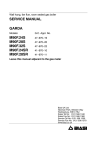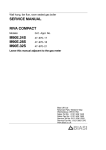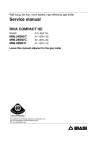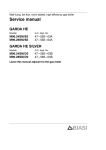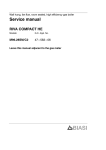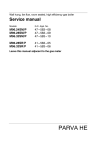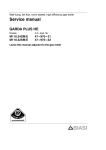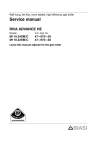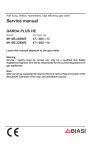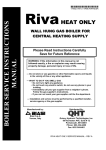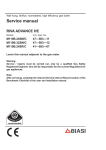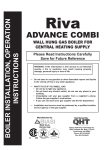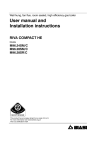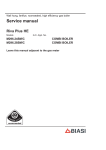Download SERVICE MANUAL RIVA COMPACT M90E.24S M90E.28S
Transcript
Wall hung, fan flue, room sealed gas boiler SERVICE MANUAL RIVA COMPACT Models: G.C. Appl. No. M90E.24S M90E.28S M90E.32S 47--970--17 47--970--18 47--970--21 Leave this manual adjacent to the gas meter Biasi U.K. Ltd Unit 31/33, Planetary Road Industrial Estate, Neachells Lane Willenhall, Wolverhampton WV 13 3XB Technical helpline: 01902 304 400 Web site: www.biasi.co.uk Table of contents 1 1.1 1.2 Overall information . . . . . . . . . . . . . . . . . . Overall View . . . . . . . . . . . . . . . . . . . . . . . . . Hydraulic diagram . . . . . . . . . . . . . . . . . . . . 2 2 2 2 2.1 2.2 2.3 2.4 2.5 2.6 General access and emptying hydraulic circuits . . . . . . . . . . . . . . . . . . . . Nomenclature . . . . . . . . . . . . . . . . . . . . . . . . Body panels . . . . . . . . . . . . . . . . . . . . . . . . . Control panel . . . . . . . . . . . . . . . . . . . . . . . . Access to the sealed chamber . . . . . . . . . Emptying the primary circuit . . . . . . . . . . . Emptying the d.h.w. circuit . . . . . . . . . . . . 3 3 3 3 4 4 4 3 3.1 3.2 3.3 Diagrams . . . . . . . . . . . . . . . . . . . . . . . . . . . Wiring diagram . . . . . . . . . . . . . . . . . . . . . . . Functional flow diagrams . . . . . . . . . . . . . . Circuit voltages . . . . . . . . . . . . . . . . . . . . . . 5 5 7 8 4 Fault finding . . . . . . . . . . . . . . . . . . . . . . . . 11 5 5.1 5.2 5.3 Primary heat exchanger . . . . . . . . . . . . . . Characteristics . . . . . . . . . . . . . . . . . . . . . . . Removal . . . . . . . . . . . . . . . . . . . . . . . . . . . . Cleaning . . . . . . . . . . . . . . . . . . . . . . . . . . . . 6 6.1 6.2 D.h.w. heat exchanger . . . . . . . . . . . . . . . 14 Function . . . . . . . . . . . . . . . . . . . . . . . . . . . . . 14 Removal . . . . . . . . . . . . . . . . . . . . . . . . . . . . 14 13 13 13 13 7 7.1 7.2 7.3 Pump . . . . . . . . . . . . . . . . . . . . . . . . . . . . . . . Function . . . . . . . . . . . . . . . . . . . . . . . . . . . . . Checks . . . . . . . . . . . . . . . . . . . . . . . . . . . . . Removal . . . . . . . . . . . . . . . . . . . . . . . . . . . . 15 15 15 15 8 8.1 8.2 8.3 8.4 Three way diverter valve . . . . . . . . . . . . . Function . . . . . . . . . . . . . . . . . . . . . . . . . . . . . Checks . . . . . . . . . . . . . . . . . . . . . . . . . . . . . Removal of the electric actuator . . . . . . . . Removal of the diverter group and its internal parts . . . . . . . . . . . . . . . . . . 16 16 16 16 9 9.1 9.2 9.3 9.4 9.5 9.6 9.7 9.8 9.9 9.10 9.11 Electronic control p.c.b. . . . . . . . . . . . . . . Function . . . . . . . . . . . . . . . . . . . . . . . . . . . . . Selection and adjustment devices . . . . . . Checking the temperature . . . . . . . . . . . . . Operation/Service lamps . . . . . . . . . . . . . . Dip---switch selectors . . . . . . . . . . . . . . . . . Setting jumpers . . . . . . . . . . . . . . . . . . . . . . Ignition gas pressure adjustment . . . . . . . Max c.h. power adjustment . . . . . . . . . . . . Checks . . . . . . . . . . . . . . . . . . . . . . . . . . . . . Removal of the electronic control p.c.b . . Thermal control in the ” ” mode . . . . . . 18 18 18 18 19 20 21 21 21 21 21 23 9.12 Thermal control in the ” 10 10.1 10.2 Full sequence ignition device . . . . . . . . . 24 Function . . . . . . . . . . . . . . . . . . . . . . . . . . . . . 24 Checks . . . . . . . . . . . . . . . . . . . . . . . . . . . . . 24 17 ” mode . . . . . . 23 10.3 10.4 Removal . . . . . . . . . . . . . . . . . . . . . . . . . . . . 24 Ignition and control sequence . . . . . . . . . . 25 11 11.1 11.2 11.3 11.4 11.5 11.6 Modulating gas valve . . . . . . . . . . . . . . . . Function . . . . . . . . . . . . . . . . . . . . . . . . . . . . . Nomenclature of the parts . . . . . . . . . . . . . Adjustment . . . . . . . . . . . . . . . . . . . . . . . . . . Checks . . . . . . . . . . . . . . . . . . . . . . . . . . . . . Removal of the on---off operator coils . . . Removal of the gas valve . . . . . . . . . . . . . . 26 26 26 26 27 27 27 12 12.1 12.2 12.3 Primary circuit flow switch . . . . . . . . . . . Function . . . . . . . . . . . . . . . . . . . . . . . . . . . . . Checks . . . . . . . . . . . . . . . . . . . . . . . . . . . . . Removal . . . . . . . . . . . . . . . . . . . . . . . . . . . . 28 28 28 28 13 Expansion vessel and temperature-- pressure gauge . . . . . . . . Function . . . . . . . . . . . . . . . . . . . . . . . . . . . . . Checks . . . . . . . . . . . . . . . . . . . . . . . . . . . . . Removal of the expansion vessel . . . . . . . Removal of the temperature---pressure gauge . . . . . . . . . . . . . . . . . . . . . . . . . . . . . . . 13.1 13.2 13.3 13.4 14 14.1 14.2 14.3 14.4 14.5 29 29 29 29 29 30 30 30 30 30 14.6 D.h.w. flow switch, filter and flow limiter Function . . . . . . . . . . . . . . . . . . . . . . . . . . . . . Nomenclature and location of parts . . . . . Checks . . . . . . . . . . . . . . . . . . . . . . . . . . . . . Removal of the flow switch sensor . . . . . . Removal of the flow switch group and d.h.w. circuit filter . . . . . . . . . . . . . . . . . Flow limiter . . . . . . . . . . . . . . . . . . . . . . . . . . 15 15.1 15.2 15.3 Temperature probe . . . . . . . . . . . . . . . . . . Function . . . . . . . . . . . . . . . . . . . . . . . . . . . . . Checks . . . . . . . . . . . . . . . . . . . . . . . . . . . . . Removal . . . . . . . . . . . . . . . . . . . . . . . . . . . . 32 32 32 32 16 16.1 16.2 By -- pass valve . . . . . . . . . . . . . . . . . . . . . . 33 Function . . . . . . . . . . . . . . . . . . . . . . . . . . . . . 33 Removal . . . . . . . . . . . . . . . . . . . . . . . . . . . . 33 17 17.5 Fan, venturi device and Air pressure switch . . . . . . . . . . . . . . . . . . Function . . . . . . . . . . . . . . . . . . . . . . . . . . . . . Checks . . . . . . . . . . . . . . . . . . . . . . . . . . . . . Removal of the Fan . . . . . . . . . . . . . . . . . . . Inspection and removal of the venturi device . . . . . . . . . . . . . . . . . . . . . . . . . . . . . . Removal of the Air pressure switch . . . . . 18 18.1 18.2 18.3 Ignition and detection electrodes . . . . . Function . . . . . . . . . . . . . . . . . . . . . . . . . . . . . Checks . . . . . . . . . . . . . . . . . . . . . . . . . . . . . Removal . . . . . . . . . . . . . . . . . . . . . . . . . . . . 36 36 36 36 19 19.1 19.2 19.3 Safety thermostat . . . . . . . . . . . . . . . . . . . Function . . . . . . . . . . . . . . . . . . . . . . . . . . . . . Checks . . . . . . . . . . . . . . . . . . . . . . . . . . . . . Removal . . . . . . . . . . . . . . . . . . . . . . . . . . . . 38 38 38 38 20 Short spare parts list . . . . . . . . . . . . . . . . 40 17.1 17.2 17.3 17.4 30 31 34 34 34 35 35 35 1 1 Overall information 1.1 Overall View Air pressure switch Fan Main heat exchanger Safety thermostat Burner Expansion vessel Combustion chamber Ignition electrodes Detection electrode Diverter valve Automatic air release valve Main circuit flow switch D.h.w. temp. probe Pump Gas valve D.h.w flow switch Control panel 1.2 Hydraulic diagram Central heating (c.h.) operation C.h. water return 2 D.h.w. heat exchanger C.h. water flow Domestic hot water (d.h.w.) operation D.h.w. inlet D.h.w. outlet 2 General access and emptying hydraulic circuits A 2.1 Nomenclature 1 2 6 Fig. 2 3 To remove the side panels loosen the screws B and C (Fig. 3), bring the base of the panels away from the boiler and lift them, freeing them from the top hooks. D 5 4 Fig. 1 1 Right side panel 2 Front panel 3 Control panel lid 4 Control panel cover 5 Service panel 6 Left side panel B C Fig. 3 --- bottom view of the boiler 2.3 2.2 Body panels Warning: isolate the boiler from the mains electricity supply before removing any covering or component. For the most part of the check and maintenance operations it is necessary to remove one or more panels of the case. The side panels can be removed only after the removal of the front panel. To remove the front panel remove screws A (Fig. 2), lift the panel and remove it. Control panel Warning: isolate the boiler from the mains electricity supply before removing any covering or component. To gain access to the parts located inside the control panel proceed as follows: 1 Remove the front panel of the case 2 Loosen the screws B and C (Fig. 3). 3 Remove the screws D 4 Move the lower part of the side panels as indicated in Fig. 4 and pull the control panel. When completely pulled out, the panel can rotate 45° downwards to facilitate the service operations on the internal parts. 3 General access and emptying hydraulic circuits To gain access to the parts contained in the sealed chamber it is necessary to remove the lid of the sealed chamber. For this purpose, remove the front and side panels of the case, remove the screws G as indicated in Fig. 6 and remove the lid. 2.5 1 Fig. 4 Emptying the primary circuit Close the c.h. circuit flow and return cocks H. (Fig. 7). Remove the screws E and remove the service panel (Fig. 5); To gain access to the electronic regulation PCB and the full sequence ignition device remove the screws F and remove the control panel lid (Fig. 5); 5 6 J H F E H Fig. 7 --- bottom view of the boiler F 2 Remove the front and right panels of the boiler. 3 Open the drain tap I (Fig. 8) until the boiler is completely emptied. 4 Close drain tap again once the emptying has been completed. Fig. 5 2.4 Access to the sealed chamber G G I Fig. 8 2.6 Fig. 6 4 Emptying the d.h.w. circuit 5 Close the d.c.w. inlet cock J (Fig. 7); 6 Open one or more hot water taps until the boiler has been completely emptied. 3 Diagrams 3.1 Wiring diagram Wiring diagram for boiler equiped with full sequence ignition device type: Bertelli & Partners FM30 1 rd bu Fan Ignition Flame detection electrodes electrode Air pressure switch ye M ~ wh gnye og vt Safety thermostat bn bu NO NC bk COM gnye gnye gnye gnye 2 gy bn 3 Electric supply terminal block gnye bu bu External controls terminal block gnye bu bn bk rd bn bu bk bn rd bk rd wh bu gy bk Electronic control p.c.b. gnye gnye ye wh og vt bk bu bn bk bu bk bu bn bk rd bk bu bu gy rd gnye bn gnye bn bu bn bk bu bu bk bn rd Full sequence ignition device bk gy bk t D.h.w. temperature probe NTC bn = brown bu = blue bk = black wh = white rd = red gy = grey gn = green ye = yellow vt = violet og = orange gnye = green/yellow bu D.h.w. flow switch bk bu Primary circuit C.h. temperature flow switch probe NTC bu bk gnye rd 1 2 3 wh t bk bk gnye bn bu bk rd rd M ~ M ~ Three way diverter valve Pump bu gnye bn gnye Modulating gas valve rd bk wh gn Time switch 5 Diagrams Wiring diagram for boiler equiped with full sequence ignition device type: Honeywell FPLD 1 rd bu Fan Air pressure switch ye M ~ wh gnye og vt Safety thermostat Ignition Flame detection electrodes electrode bn bu NO NC bk COM gnye gnye gnye gnye 2 gy bn 3 Electric supply terminal block gnye bu bu External controls terminal block gnye bu bn bk rd bn bu bk bn rd bk rd wh bu gy bk Electronic control p.c.b. bn gnye gnye ye wh og vt bk bu bu bk bn bk bu bn bk rd bk bu bu gy rd gnye bn gnye bu bn bk bu bu bn bu bk rd rd bk bk bu bk bu t t DHW temperature probe NTC DHW flow switch Primary circuit flow switch CH temperature probe NTC Three way diverter valve bk gy bu bn gnye wh 1 2 3 rd bk Full sequence ignition device rd bn bk gnye M ~ M ~ bu gnye bn gnye Modulating gas valve Pump rd bk wh bn = brown bu = blue bk = black wh = white rd = red gy = grey gn = green ye = yellow vt = violet og = orange gnye = green/yellow 6 gn Time switch Diagrams 3.2 Functional flow diagrams General layout J1--- 1 Fuse 1,6A T Electronic control p.c.b. (low voltage section) PTC Transformer L J3--- 5 J3--- 4 J3--- 3 Three way diverter valve J1--- 2 N Pump J3--- 1 J3--- 2 J2--- 5 J2--- 4 Full sequence ignition device Heat request on d.h.w. Electronic control p.c.b. (low voltage section) J1--- 1 Fuse 1,6A T PTC Transformer L J3--- 5 J3--- 4 J3--- 3 Three way diverter valve J1--- 2 N Pump L --- LINE J3--- 1 J3--- 2 J2--- 5 J2--- 4 N --- NEUTRAL ACTIVE CIRCUIT INACTIVE CIRCUIT Full sequence ignition device Heat request on c.h. Electronic control p.c.b. (low voltage section) J1--- 1 Fuse 1,6A T PTC Transformer L J3--- 5 J3--- 4 J3--- 3 Three way diverter valve J1--- 2 N Pump J3--- 1 J3--- 2 J2--- 5 J2--- 4 Full sequence ignition device 7 Diagrams 3.3 Circuit voltages Diagrams for boiler equiped with full sequence ignition device type: Bertelli & Partners FM30 during c.h. or d.h.w. operation Electrical voltages with burner on only during c.h. operation 230~ 0 230~ 230~ 230~ Pump 0 3 way diverter valve Supply network only during d.h.w. operation 230~ Full sequence Ignition device 230~ 230~ 230~ 0 0 Modulating Gas valve 0 Safety thermostat Fan 230~ Air pressure switch 0 Electronic control p.c.b. Electronic control p.c.b. 230~ 8 Diagrams Diagrams for boiler equiped with full sequence ignition device type: Honeywell FPLD during c.h. or d.h.w. operation Electrical voltages with burner on only during c.h. operation 230~ 0 230~ 230~ 230~ Pump 0 3 way diverter valve Supply network only during d.h.w. operation 230~ Full sequence Ignition device 230~ 230~ 230~ 0 0 Modulating Gas valve 0 Safety thermostat Fan 230~ Air pressure switch 0 Electronic control p.c.b. Electronic control p.c.b. 230~ 9 Diagrams 10 11 J By pressing the reset push--- button the boiler starts the ignition cycle. The burner lights on, the ignition sparks continue and the boiler locks again. --(5) D.h.w. heat exchanger 8.2 Diverter valve D.h.w. circuit C.h. circuit 9.9 J J D.h.w. flow switch The boiler lights for a short while on c.h. Normal operation on d.h.w. function. J Fuse (regulation p.c.b.) J J 7.2 Pump 6 Regulation p.c.b. The boiler doesn’t control the d.h.w. temperature. Turning the d.h.w. temp. adjustment knob hasn’t effect on the modulation of the flame. The boiler operates correctly on c.h. The burner doesn’t light either in c.h. or d.h.w. mode. Fan doesn’t turn. The burner doesn’t light either in c.h. or d.h.w. mode. Fan turn. J By pressing the reset push--- button the boiler starts the ignition cycle. The burner doesn’t light on, the ignition sparks continue and the boiler locks again. J J J Power supply line J --(3) Gas supply line By pressing the reset push--- button the boiler turns on and operates correctly. The boiler does not start either in c/h or d.h.w. mode. Fan still. Defect # --(4) Flue pipes --(2) 10.2 Full sequence device J J J Gas valve (on--- off operators) J Gas valve (modulating operator) J (7) 12.2 14.5 Main circuit flow switch J 15.2 Main circuit temp. probe J J D.h.w. temp. probe J J 16 By--- pass valve J 17.2 Fan and venturi device J J Air pressure switch J J 18.2 Ignition electrode J J J Detection electrode D.h.w. filter 11.4 19.2 J J Safety thermostat Section of the manual ! (note ref. in brackets) J J --(9) --(8) Injectors Components to check Expansion vessel Fault finding --- --- Safety valve 4 Appliance operation lamp green (1) ON --- fast pul ulses ON --- fasst pulses OFF Lock--- out signal lamp red OFF ON OFF Pressure gauge Function selectors (reg. p.c.b) --- --- Appliance operation lamp green (1) ON ----- norm mal pulsess --- --- For details see section 9.4 of this manual. Further useful information can be obtained by switching the electronic control p.c.b. in the service operation mode (see section 9.4 of this manual). Check for 230V~ between line (L) and neutral (N) Verify the integrity of supply cable, plug and external fuses. Check the polarity of line and neutral connection Verify the soundness of the gas supply pipe, the position of 2 3 Water leaks from the safety valve when the boiler is off. Water leaks from the safety valve during operation on c/h Low d.h.w. flow rate Poor d.h.w. temperature The boiler operates correctly but the gas pressure to the burner remains at minimum. Noisy bolier Incorrect modulation J Power supply line J C.h. circuit J D.h.w. flow switch J 9.9 Regulation p.c.b. J J J J Function selectors (reg. p.c.b) J J J J 12.2 14.5 Gas valve (on--- off operators) Full sequence device Fuse (regulation p.c.b.) Check for soundness and absence of obstructions. Verify that the flue terminal is correctly installed (see clearances) and ensure that exhaust gas is not sucked back by the boiler. Check for soundness of the circuit and verify its correct filling (see also installation manual). 5 J D.h.w. filter 10 8 9 7 6 J (10) 15.2 16 17.2 Fan and venturi device 19.2 --(8) Injectors J J --(9) Expansion vessel Ignition electrode Air pressure switch By--- pass valve D.h.w. temp. probe Main circuit temp. probe J J J J --- --- A jammed by--- pass could cause the over--- heating of the main circuit and the intervention of the safety thermostat. Check the minimum gas pressure at the outlet test point of the gas valve (see sect. 11.3) and compare it with the value given on the installation booklet. Verify the cleanness of injectors. Check the pressurization of the expansion vessel. Refer to the installation manual for proper values. d.h.w. pressure too high or flow rate too high. If necessary insert a flow rate limiter (14.6). J 18.2 Detection electrode 11.4 Safety valve Components to check 10.2 Gas valve (modulating operator) stop valves. Check the gas pressure at the inlet test point of the gas valve (see sect. 11.3) with the boiler at rest and during operation and compare it with the values given on the installation booklet. J J 8.2 Main circuit flow switch 4 J J D.h.w. circuit J 7.2 6 D.h.w. heat exchanger On c/h mode the temperature of the main circuit reaches 75°C and the c/h system does not heat. The boiler operates correctly on d.h.w. mode. Gas supply line 1 Note Lock--- out signal lamp red OFF F --(5) Pump J --(3) Diverter valve The boiler does not supply d.h.w. (cold water from the tap). Regular operation in c/h mode even during a drawing off d.h.w. Defect # --(4) Flue pipes --(2) Safety thermostat Section of the manual ! (note ref. in brackets) Pressure gauge 12 5 Primary heat exchanger 5.1 Characteristics C G The primary heat exchanger A in Fig. 9 has the function of transferring heat produced from combustion of the gas to the water circulating in it. F B A E D Fig. 11 5 Unscrew the connection H (Fig. 12), lift the pipe I and rotate it right then move it downwards freeing it from the heat exchanger connection. 6 Remove the motor of the three way diverter valve (see section 8.3). Completely unscrew the connection J and rotate the pipe K. downwards freeing it from the heat exchanger connection. Remove the heat exchanger by sliding it forwards. Reassemble the boiler carrying out the removal operations in reverse order. Fit the clips F with the arrow pointing upwards as illustrated in Fig. 11. 7 8 9 Fig. 9 The hydraulic circuit is composed of 8 elliptical pipes connected in parallel (Fig. 10). I H J Fig. 10 5.2 K Removal Warning: isolate the boiler from the mains electricity supply before removing any covering or component. 1 Empty the primary circuit of the boiler. 2 Remove the case panels and the sealed chamber lid (see section 2). 3 Remove the combustion chamber lid B by unscrewing the screws C (Fig. 11). 3b For model M90E.28S and M90E.32S only, remove the screw D and the plate E. 4 Remove the clips F and the safety thermostat G. It is not necessary to disconnect it from the wiring. Fig. 12 5.3 Cleaning If there are deposits of soot or dirt between the blades of the heat exchanger, clean with a brush or non---metallic bristle brush. In any case, avoid any actions that can damage the protective varnish with which the exchanger has been covered. Warning: After cleaning or replacement as detailed above refer to section Combustion analysis check in the chapter Maintenance of the installation instructions manual. 13 6 D.h.w. heat exchanger 6.1 Function 6.2 The d.h.w heat exchanger A in Fig. 13 allows the instantaneous transfer of heat from the primary hydraulic circuit to the water destined for d.h.w use. Warning: isolate the boiler from the mains electricity supply before removing any covering or component. 1 2 3 A Removal 4 Remove the front and right hand side panels of the case. Empty the primary circuit and the d.h.w circuit of the boiler. Remove the motor of the three way diverter valve (see section 8.3). Completely unscrew the two Allen key screws B (Fig. 15) which hold the exchanger to the brass groups. B Fig. 15 5 Fig. 13 The schematic structure is shown in Fig. 14. Reassemble the d.h.w. heat exchanger carrying out the removal operations in the reverse order. Attention. When reassembling the exchanger be sure to put the off center location/securing pin indicated in Fig. 16 towards the left side of the boiler. Primary hydraulic circuit Domestic hot water circuit Fig. 14 14 Move the exchanger towards the rear of the boiler and extract it. Fig. 16 7 Pump 7.1 Function The pump A in Fig. 17 has the function of making the water in the main circuit circulate through the main heat exchanger and therefore through the c.h. system (during the c.h. function) or through the secondary heat exchanger (during the d.h.w. function). n Check that the impeller is integral with the rotor. With the boiler off remove the front and right hand side case panels, lower the control panel and empty the primary circuit. Remove the pump head by undoing the screws which hold it to the pump body and check that the impeller is firmly joined to the rotor. 7.3 Removal Warning: isolate the boiler from the mains electricity supply before removing any covering or component. A 1 2 3 4 5 Remove the front and right hand side case panels Empty the primary circuit of the boiler. Extract and lower the control panel. Disconnect the connector B (Fig. 18). Unscrew the connection C and move the pipe upwards freeing it from the outlet port of the pump. Remove the fork D and the capillary pipe Remove the locking plate E right (Fig. 18). 6 7 C B D Fig. 17 7.2 E Checks Warning: isolate the boiler from the mains electricity supply before removing any covering or component. n Check that the pump is not seized and that the movement of the rotor is not subject to mechanical impediments. Fig. 18 8 9 Loosen the connection F, remove the fork G and the pipe H. Unscrew the two screws I that hold the pump on the frame (Fig. 19)and remove the pump towards the front of the boiler. With the boiler off, remove the front panel. Remove the air release plug of the pump and turn the rotor with a screwdriver. n G H Check the electrical continuity. F With the boiler off, remove the front panel and disconnect the connector B (Fig. 18). Measure the electrical resistance between the pump supply connections. Electrical resistance of the windings (at ambient temperature) must be about 230 W n Check the absence of starting defects. With the boiler off remove the front case panel. Remove the air release plug from the pump. Start the boiler and with a screwdriver, turn the rotor in the direction of the arrow. If there is a defect in starting, the rotor will begin to turn normally only starting it manually. I Fig. 19 Reassemble the pump carrying out the removal operations in the reverse order. When reassembling the pump, check the correct location of the O---ring gasket in the inlet port of the pump that seals the connection between the pump and the brass group . 15 8 Three way diverter valve 8.1 Function B Spindle B not visible 1 2 3 The diverter valve A (Fig. 20) has the function of modifying the hydraulic circuit of the boiler by means of an electric command given by the electronic control p.c.b. in order to send the water that exits the primary heat exchanger towards the c.h. system or towards the d.h.w. heat exchanger. 9,4 Kohm bn 0V bu bk Open circuit 230 V bn = brown bu = blue bk = black Fig. 21 --- D.h.w. mode B 1 2 3 Spindle B visible Open circuit n Checks Check the electrical continuity Fig. 21 indicates the relationship between the electric command coming from the electronic control p.c.b. and the position of the actuator B (brass spindle) when the boiler operates in d.h.w. mode. Fig. 22 indicates the relationship between the electric command coming from the electronic control p.c.b. and the position of the actuator B (brass spindle) when the boiler operates in c.h. mode. In both figures the relationship between the position of the actuator and the resistance of the motor windings (the motor must be disconnected from the wiring) is also given. 16 bn bu 230 V Fig. 20 8.2 9,4 Kohm bk bn = brown bu = blue bk = black 0V A Fig. 22 --- C.h. mode 8.3 Removal of the electric actuator Warning: isolate the boiler from the mains electricity supply before removing any covering or component. 1 2 3 Remove the front case panel. Disconnect the connectors C (Fig. 23). Remove the fixing spring D and remove the actuator E. Reassemble the actuator carrying out the removal operations in the reverse order. When reassembling the actuator, refer to Fig. 21 or to the wiring diagram in section 3.1 for the correct wiring connection. Three way diverter valve 9 E C Unscrew the screw L and remove the diverter group. D J K Fig. 23 L 8.4 Removal of the diverter group and its internal parts 1 2 Remove the front and both side case panels. Empty the primary circuit and the d.h.w circuit of the boiler. Remove the electric actuator (see section 8.3). Remove the fixing spring F (Fig. 24) and remove the primary circuit flow switch G. Disconnect the c.h. temperature probe H. Unscrew the connector I, the c.h. flow connector and the d.h.w. outlet connector. 3 4 5 6 I Fig. 25 Rear view of the boiler 10 Refer to the exploded view in Fig. 26 to remove the internal parts of the three way diverter valve. F H G Fig. 24 7 8 Remove the d.h.w. heat exchanger (see section 6.2). Remove the fork J and move away the pipe K (Fig. 25). Fig. 26 11 Reassemble the diverter group carrying out the removal operations in the reverse order. 17 9 Electronic control p.c.b. 9.1 Function Inlet Information On the Electronic control p.c.b....... Function control* C.h. temperature adjustment* D.h.w. temperature adjustment* Function dip---switches Max. c.h. gas pressure adjustment Ignition gas pressure adjustment Boiler reset button* *control panel fascia From other boiler devices.... C.h. temperature probe NTC D.h.w. temperature probe NTC D.h.w. flow switch Primary circuit flow switch Room thermostat (if fitted) Time switch Flame presence signal* *from the full sequence ignition device The fundamental function of the Electronic control p.c.b. is that of controlling the boiler in relation to the external needs (i.e. heating the dwelling or heating the water for d.h.w. use) and operating in order to keep the temperature of the hydraulic circuits constant. This is obviously possible within the useful power and maximum working temperature limits foreseen. Generally, the Electronic control p.c.b. receives inlet information coming from the boiler (the sensors) or from the outside (knobs, room thermostat, etc.), processes it and consequently acts with outlet commands on other components of the boiler (Fig. 27). 9.2 Selection and adjustment devices On the Electronic control p.c.b. several selection, adjustment and protection devices are located. (Fig. 28). Some of these devices are directly accessible by the user (function control, temperature adjustment potentiometers etc.) others are accessible by removing the service panel or the control panel lid. 14 1 13 12 2 11 10 9 8 7 6 5 4 3 Fig. 28 Outlet command Pump Three way diverter valve Full sequence ignition device Modulation operator Appliance operation light* Operation/service lamps Lock ---out signal lamp* *control panel fascia Fig. 27 18 1 2 3 4 5 6 7 8 9 10 11 12 13 14 9.3 J3 connector J2 connector Lock ---out signal lamp Boiler reset button Function control / C.h. temperature adjustment D.h.w. temperature adjustment Service lamps (service mode) Appliance operation lamp (normal use mode) Dip---switch selectors Setting jumpers Ignition gas pressure adjustment (ACC.) Maximum c.h. gas pressure adjustment (RISC.) J1 connector Fuse 1,6 A T Checking the temperature The Electronic control p.c.b. makes it possible to separately adjust the c.h. water flow temperature and d.h.w. outlet temperature. The temperature of the water is converted into an electric signal by means of temperature probes. Electronic control p.c.b. The user, setting the desired temperature with the control panel knobs operates the variable elements (5 and 6 in Fig. 28) of the electronic control p.c.b. If the power requested is lower than 40% of the maximum power output then control is achieved by switching ON the burner at minimum power, then switching OFF (ON/OFF function). If the power requested is higher, then the burner is switched ON at maximum power and will control by modulating to 40% of the maximum power output. During the c.h. operation (Fig. 29), the signal coming from the c.h. temperature probe is compared to the signal given by the control panel through the adjustment made by the user (knob ). The result of such a comparison operates the modulation of the gas valve, consequently changing the useful output of the boiler. 75 ° C Fig. 30 Normally, the result of the comparison between these two signals directly operates the adjustment elements of the gas valve modulation device, adjusting the useful output generated in order to stabilize the temperature of the exiting water. If during the d.h.w. mode operation, the temperature of the primary circuit goes over 75°C, the useful output is automatically reduced so that the primary circuit cannot reach excessive temperatures. function and in funcThe control sequences in tion are illustrated in detail in sections 9.11 and 9.12. 9.4 Fig. 29 When the boiler functions in d.h.w. (Fig. 30), the signal coming from the d.h.w. temperature probe is compared with the signal given by the control panel through the adjustment made by the user (knob ). Operation/Service lamps The Electronic control p.c.b. is provided with three lamps (L.E.D. indicators) 7 in Fig. 28 that give optical information during the normal operation of the boiler or for service purpose. f Normal operation Only the green lamp on the left is directly visible on the control panel fascia and it gives information during the normal operation of the boiler. The other two lamps are normally switched off. 19 Electronic control p.c.b. The following table gives the relationship between the visible lamp indication and its meaning. Normally operating boiler Boiler in stand --- by condition. (function control in position). A short pulse every 4 seconds C.h. operation D.h.w. operation Anti--- freeze system active. Boiler ON condition (function control in position) Frost protect operation or D.h.w. operation Excessive temperature on primary circuit 1 second ON 1 second OFF Faulty boiler or irregular operation as: Very fast pulses (4 per second) Faulty c.h. temperature probe NTC --- Empty primary circuit Faulty d.h.w temperature probe NTC --- No primary circuit flow --- Lack of burner ignition Faulty primary circuit (no water or absence of flow) --- Excessive temperature in the primary circuit. Lack of burner ignition (no ignition signal from the full seqence ignition device) --- Dip --- switch 3 left in the OFF position --- Faulty temperature probe f Ignition gas pressure adjustment Service operation Minimum gas pressure adjustment With the boiler switched ON ( or ), by moving and re---setting to its original position any of the function selectors 9 (Fig. 28), the Electronic control p.c.b. goes into service operation mode and all the lamps (7 in Fig. 28) are then activated. To reset the Electronic control p.c.b. to the normal operation it is necessary to turn the knob to the position or switch off the boiler for a short while at the fused spur isolation switch. The following table gives the relationship between each of the possible lamp combinations and their meaning. Lack of power supply or fauly electronic control p.c.b. * Fauly electronic control p.c.b. * Lamp OFF Lamp ON Flashing lamp, alone or simultaneously with an other lamp. Flashing lamp, alternate with another lamp. * These conditions are normal only for a short time when the power supply is applied to the boiler. If permanent they indicate a faulty p.c.b. 9.5 Dip---switch selectors The function selectors 9 (Fig. 28 and Fig. 31) are microswitches with which it is possible to select the various boiler control function modes. In Fig. 31 the selectors are illustrated in the configuration in which the boiler is set in the factory (natural gas boiler). Minimum gas pressure adjustment Gas conversion Ignition gas pressure adjustment Reignition frequency 1 2 3 4 ON (1) OFF (0) 9 Fig. 31 f Selector 1 This forces the boiler to operate at the minimum gas pressure in order to allow the adjustment of the minimum gas pressure at the burner (on the modulation operator of the gas valve). 20 Electronic control p.c.b. After any adjustment operation the selector has to be brought back to the normal position (ON). f Selector 2 This selects the boiler functions on the basis of the type of gas used. It allows the selection of the maximum supply current given to the modulator device. To set selector 2 correctly follow the table in Fig. 32. Gas supply Position of selector Approx. Max current through the modulator device Natural gas On 120 mA L.P.G. Off 165 mA Fig. 32 f Selector 3 This forces the functioning of the boiler in order to allow the optimal gas pressure at the burner to be adjusted during the ignition phase. The adjustment (see section 9.7) is done by means of the potentiometer ”11” marked “ACC” (Fig. 28 on page 18). After the adjustment operations bring the selector back to the normal position (ON). ON (1) OFF (0) gas pressure calibration Normal Selector 4 This allows you to select the minimum time that must pass between two ignitions of the burner in c.h. function. ON (1) 30 sec. OFF (0) This pressure is maintained at the injectors until ignition occurs (ionization signal from the full sequence ignition device). To carry out the adjustment move the function selector 3 to the OFF position (Fig. 33) and use the adjustment device ”11” (ACC). Adjust the gas pressure at the injectors to the value indicated in the tables of the User/Installation manual (Technical information section, Gas pressures at the burner table). By rotating the device clockwise the pressure increases. Check the regular ignition of the burner by turning the boiler on and off repeatedly. After the adjustment operations bring the selector 3 back to the normal position (ON). 9.8 n Check that the fuse is complete If the Electronic control p.c.b. does not supply any device (pump, fan, etc.) check that the fuse 14 (Fig. 28) is complete. If the fuse has blown replace it with one that has the same characteristics after having identified the reason for failure. n Check the setting jumpers position 3 min. 9.10 Refer to Fig. 35 for the position of the jumpers. The numbers refer to the marking printed on the circuit board. Removal of the electronic control p.c.b Warning: isolate the boiler from the mains electricity supply before removing any covering or component. Setting jumpers 1 2 3 12 3456 789 Checks Two setting jumpers must be fitted on the Electronic control p.c.b. as shown in Fig. 35 and NO TAG. Two setting jumpers are fitted on the Electronic control p.c.b. Fig. 35 Max c.h. power adjustment By using device 12 (Fig. 28) marked “RISC.” on the Electronic control p.c.b., you can limit the maximum useful output delivered during the c.h. operating mode. This adjustment does not influence the maximum useful output delivered during the d.h.w. operating mode. By rotating the device clockwise the pressure increases. Fig. 34 9.6 Ignition gas pressure adjustment By using the device ”11” (Fig. 28) marked “ACC.” on the Electronic control p.c.b., it is possible to adjust the gas pressure at the injectors in the ignition phase. 9.9 Fig. 33 f 9.7 Gain access to the parts located inside the control panel as explained in the section 2.3 of this manual. Remove all the wiring connected to the Electronic control p.c.b.. To disconnect the connectors J1, J2 and J3 (13, 2 and 1 in Fig. 28) delicately flex the hook present on one side of each socket. Remove the spindles of the c.h. and d.h.w. temperature adjustment knobs by delicately pulling them with pliers in the direction shown by the arrow in Fig. 36. 21 Electronic control p.c.b. sure of the contact between the boiler reset button B and the tab C (Fig. 37). Fig. 36 4 5 6 Unscrew the four screws that hold the Electronic control p.c.b. on to the control panel. Remove it by lifting its rear edge and freeing it from any of the wiring. Re---assemble the Electronic control p.c.b. following the removal procedures in the reverse order. Important A 8 9 22 Fit the p.c.b. into the control panel by first inserting the front lower edge under the control knob shafts. Lower the rear edge and ensure that no wiring is trapped beneath. Insert the spindles in the control panel knobs untill the notch A (Fig. 37) reaches the potentiometer edge. It is not necessary to force them in the knob. While tightening the screws that fix the Electronic control p.c.b. on the control panel, keep the p.c.b. towards the control panel fascia making C Fig. 37 Attention After installing the Electronic control p.c.b. : 10 Make sure the c.h. ( ) and d.h.w. ( ) temperature adjustment knobs can move freely for the complete range. If not, remove the spindle again as described at step 3, turn the knob half a turn and re---insert the spindle. 11 Operate the boiler and close the gas inlet cock so that the boiler goes into the safety lock ---out state. Verify the correct operation of the boiler reset button by pressing and releasing it. When re---assembling the Electronic control p.c.b.: 7 B Warning: After cleaning or replacement as detailed above refer to section Combustion analysis check in the chapter Maintenance of the installation instructions manual. Electronic control p.c.b. 9.11 Thermal control in the ” ” mode Switch in the See functioning with the function control in the mode YES (sec. 9.12) function mode Taking water from the domestic hot water circuit? Is primary circuit temperature higher than that selected? YES NO Request for heat from room thermostat? Circulator off Operates motorised valve Ignition device off NO NO YES Starts the circulator Operates motorised valve Supplies the ignition device Fig. 38 9.12 Thermal control in the ” ” mode Switch in the YES function mode Taking water from the domestic hot water circuit? NO Circulator off Ignition device off Circulator on YES Supplies the ignition device Is domestic hot water outlet temperature lower than that required? NO Ignition device off Fig. 39 23 10 Full sequence ignition device 10.1 Function The Full sequence ignition device used on the boiler carries out the following fundamental functions: f does a sequence of operations (ignition cycle) which lead to the ignition of the gas at the burner f checks the presence of the flame during the entire period in which it is activated f supplies the fan and checks its functioning by means of the signal coming from the air pressure switch. The Full sequence ignition device is supplied by the electronic control p.c.b. when the ignition of the burner is requested. The Full sequence ignition device has a safety function and any incorrect interventions or tampering can result in conditions of dangerous functioning of the boiler. The Full sequence ignition device can lock the functioning of the boiler (lock state) and stop its functioning up to the resetting intervention. The lock is signalled by the lighting of the lock ---out signal lamp and the device can be reset only by using the boiler reset button placed on the control panel fascia. Some components which are connected to the device can activate the lock state. The causes of a lock state could be: f The intervention of the safety thermostat (overheat of the primary circuit). f A fault on gas supply f Faulty ignition (faulty ignition electrodes, their wiring or connection). f Faulty flame detection (faulty detection electrode, its wiring or connection). f Gas injectors blocked f Faulty modulation gas valve (faulty on---off operators or not electrically supplied). f Faulty Full sequence ignition device. With the burner firing, interrupt the gas supply. The Full sequence ignition device must carry out a complete ignition cycle and then stop. By turning the boiler on and off by means of the function switch the device must not unlock and the burner must not turn on. Fan functioning device n With the boiler operating and the burner on, open the negative pressure test point of the Venturi device. At the moment of opening the burner must turn off. 10.3 Removal Warning: isolate the boiler from the mains electricity supply before removing any covering or component. 1 Gain access to the parts located inside the control panel as explained in the section 2.3 of this manual. 2 Remove all the wiring connected to the Full sequence ignition device. To disconnect the connectors A, delicately flex the hook present on one side of each socket (Fig. 40). 3 Unscrew the two screws B that hold the Full sequence ignition device on the panel and remove the component. A B Other components like the air pressure switch can temporarily stop the ignition of the burner but allow its ignition when the cause of the intervention has stopped. Fig. 41 shows the sequence of the operations that are carried out at the start of every ignition cycle and during normal functioning. 10.2 Checks n Lock sequence Start the boiler until the burner is ignited. 24 B A Fig. 40 4 Re---assemble the Full sequence ignition device following the removal procedures in the reverse order. Full sequence ignition device 10.4 Ignition and control sequence supply from the electronic control circuit YES lock memorised? NO cancels lock NO Air pressure switch at rest? YES starts fan NO Air pressure switch at work? YES beginning of wait period NO NO presence of flame? YES Air pressure switch at work? YES starts ignition discharges opens gas valve beginning of ignition period NO end of ignition period? NO YES NO flame presence? YES closes gas valve stops fan interrupts ignition discharges memorizes lock turns on lock--- out light interrupts ignition discharges gas valve open reset push--- button pressed? YES closes gas valve YES flame presence? NO YES Air pressure switch at work? NO Safety thermostat opens the circuit? YES NO Fig. 41 25 11 Modulating gas valve 11.1 Function The Modulating gas valve A in Fig. 42 controls the gas inflow to the boiler burner. 1 8 7 2 3 6 5 4 Fig. 43 11.3 Adjustment Warning: isolate the boiler from the mains electricity supply before removing any covering or component. A 1 Remove the front panel of the case. 2 Open the gas valve inlet pressure test point (6 in Fig. 43) at the valve input, connect a suitable pressure gauge and check the gas pressure of the supply network. 3 Remove the gauge and close the pressure test point 6. 4 Open the gas valve outlet pressure test point (8 in Fig. 43) and connect the gauge; Remove the protection cap from the mechanical pressure adjustment components; 5 Fig. 42 By means of an electric command given to the on---off operators the passage of the gas through the Modulating gas valve can be opened or closed. By means of an electric command given to the modulation operator the pressure can be varied and therefore the gas flow rate to the burner (modulation). The modulation operator has mechanical components which allow the adjustment of the minimum and maximum pressure exiting the valve. 11.2 Nomenclature of the parts (Fig. 43) 6 Start the boiler at its maximum power. Operate the boiler in d.h.w. mode or ensure that the boiler is not range rated if the test is carried out in c.h. mode. 7 Rotate the maximum gas pressure adjustment (4 in Fig. 43) until you obtain the required pressure (by rotating clockwise the pressure increases). Disconnect one of the two connectors (1 in Fig. 43) or, alternatively, remove the service panel as explained in the section 2.3 of this manual and set the dip---switch selector 1 (see section 9.5) to the OFF position. Rotate the minimum gas pressure adjustment (2 in Fig. 43) until you obtain the required pressure (by rotating clockwise the pressure increases). 8 9 1 Modulation operator’s electric connectors 2 Minimum gas pressure adjustment 3 On---off operators 4 Maximum gas pressure adjustment 5 On---off operators electric connector 6 Gas valve inlet pressure test point 12 7 Modulation operator 8 Gas valve outlet pressure test point Important: after the gas pressure checks and any adjustment operations, all of the test points must be sealed. 26 10 11 Turn the boiler off and re---connect the wire to the modulating operator (or set the dip---switch selector 1 back to the ON position). Start the boiler and check again the maximum gas pressure setting. Turn the boiler off and disconnect the gauge. Modulating gas valve 11.4 11.6 Checks Warning: isolate the boiler from the mains electricity supply before removing any covering or component. n 1 2 n 1 2 3 Check the modulation operator coil Remove the front panel of the case. Disconnect the connectors B (Fig. 46) from the modulating operator and measure the electrical resistance of the coil. Its electrical resistance value must be approx. 80 W*. Check the on---off operators coils Remove the front panel of the case. Disconnect the electrical connector C (Fig. 46). Measure the electrical resistance between the connector pins of the on---off operators as illustrated in Fig. 44. Upper on---off operator approx. 6 400 W* Warning: isolate the boiler from the mains electricity supply before removing any covering or component. 1 Remove the front panel of the case as explained in the section 2.3 of this manual. 2 Disconnect the connectors B and C (Fig. 46). 3 Turn off the gas supply and disconnect the gas isolation cock connector from the inlet port of the gas valve. 4 Unscrew the connectors F and remove the pipe G 5 Unscrew the screws H and remove the valve. 6 Reassemble the valve carrying out the removal operations in reverse order. After any service operation on the components of the gas circuit check all the connections for gas leaks. Lower on---off operator approx. 920 W* * at ambient temperature. Warning: After cleaning or replacement as detailed above refer to section Combustion analysis check in the chapter Maintenance of the installation instructions manual. Fig. 44 11.5 Removal of the gas valve Removal of the on---off operators coils Warning: isolate the boiler from the mains electricity supply before removing any covering or component. 1 2 3 4 Remove the front panel of the case as explained in the section 2.3 of this manual. Disconnect the connector D (Fig. 45). Unscrew the screw E and remove on---off operator coils. Reassemble the coils carrying out the removal operations in reverse order. G F B C H D E Fig. 46 Fig. 45 27 12 Primary circuit flow switch 12.1 Function The Primary circuit flow switch (A in Fig. 47) function is to detect water flowrate through the primary hydraulic circuit of the boiler. 12.2 Checks Warning: isolate the boiler from the mains electricity supply before removing any covering or component. n 1 2 3 Mechanical function Remove the front panel of the case. Start and stop the boiler either in d.h.w. or c.h. mode. Looking through the switch box verify the position of the shaft B referring to Fig. 49. Boiler OFF B Boiler ON Fig. 49 A I n Electrical check It is possible to verify the general operation of the switch by measuring the electric resistance between the contacts C. and N.O. of the switch. 1 Remove the switch as explained in section 12.3. 2 Measure the electrical resistance between the tabs marked C. and N.O. (Fig. 50). The contact must be normally open. 3 Operate the switch by hand and verify that the contact is now closed. C N.O. Fig. 47 This hydraulic/membrane operated electrical micro--switch device will control the functioning of the ignition control circuit, providing there is an adequate quantity and flow of water in the primary circuit. Any failure of the pump or obstructions in the primary circuit, whilst in either c.h. or d.h.w. modes, will not allow the device to operate. This device is connected to the electronic control p.c.b. and if, after the pump operates, it does not activate within 20 seconds the control board will indicate that a fault condition (see section 9.4 of this manual) has occurred. do not use Fig. 50 12.3 Warning: isolate the boiler from the mains electricity supply before removing any covering or component. n 1 2 3 4 C D n 1 2 3 Fig. 48 28 Removal Removal of the switch Remove the front and right hand side panels of the case. Remove the fork C (Fig. 48). Open the box and disconnect the switch. Re---assemble the parts in reverse order of removal. Refer to Fig. 50 for the correct wiring connectors on the switch Removal of the membrane Remove the front and right hand side panels of the case, turn off the flow and return isolation valves and empty the primary circuit. Remove the fork C that holds the micro---switch housing D (Fig. 48). Unscrew the four screws E (see Fig. 51) open the hydraulic operator and remove the membrane F. F Warning: isolate the boiler from the mains electricity supply before removing any covering or component. G E 1 Remove the front and left hand side panels of the case, turn off the flow and return isolation valves and empty the primary circuit. Completely unscrew the connection K, the locknut L (Fig. 53) and remove the expansion vessel from the top of the boiler. H 2 Fig. 51 4 Reassemble the parts in reverse order of removal. L When assembling the membrane, ensure that its concave side faces towards the actuator plate G and the reference indicated aligns with the seat H (see Fig. 51). 13 Expansion vessel and temperature---pressure gauge 13.1 Function The Expansion vessel (I in Fig. 47) function is to allow for the volume expansion of the c.h. circuit water due to the temperature rise. 13.2 1 2 K Fig. 53 3 Checks Turn off the flow and return isolation valves and empty the primary circuit of the boiler. Remove the protective cap J (Fig. 52) from the valve on the top of the expansion vessel and connect a suitable air pressure gauge. Re---assemble the parts in reverse order of removal. 13.4 1 Remove the front and right hand side panels of the case, turn off the flow and return isolation valves and empty the primary circuit. Remove the fork M and the probe holder spring N (Fig. 54). Squeeze the tabs O to release the temperature--pressure gauge P and remove it. Re---assemble the parts in reverse order of removal. 2 J 3 4 Fig. 52 3 13.3 Check the pre---load pressure and refer to the section Expansion vessel in the User manual and installation instructions for the correct value. Removal of the temperature---pressure gauge O P Removal of the expansion vessel If there is at least 400 mm clearance above the boiler and the rear exit flue can be easily removed, the expansion vessel can be changed without removing the boiler. M N Fig. 54 29 14 D.h.w. flow switch, filter and flow limiter 14.1 Function The d.h.w. flow switch A in Fig. 55 is a device that generates an electrical signal when hot water is drawn. 14.2 1 2 3 4 5 6 7 8 9 10 Nomenclature and location of parts (Fig. 57) Flow switch sensor Plug Magnetic ring Float Spring Filter Body Spring seat Flow limiter (M90E.28S optional accessory) Threaded ring 7 8 9 10 6 A 4 5 3 2 1 Fig. 57 14.3 Warning: isolate the boiler from the mains electricity supply before removing any covering or component. Fig. 55 When the flow rate through the d.h.w. circuit reaches about 2,5 litres/min’, the float 4 (Fig. 57) is drawn towards the right. The resulting magnetic field of ring 3 increases and reaches the flow switch sensor 1. The sensor generates an electrical signal that switches the boiler d.h.w operation ON. The state of the sensor is also indicated by means of the lamp B placed on the sensor body. Checks n 1 2 14.4 Flow switch sensor operation Remove the front panel of the case. Switch on the boiler and open a d.h.w. tap. The lamp B (Fig. 56) placed on the sensor body is switched on when the flow rate reaches about 2,5 litres/min’. Removal of the flow switch sensor Warning: isolate the boiler from the mains electricity supply before removing any covering or component. 1 2 C B 14.5 Fig. 56 Removal of the flow switch group and d.h.w. circuit filter Warning: isolate the boiler from the mains electricity supply before removing any covering or component. 1 30 Remove the front panel of the case. Disconnect the connector C (Fig. 56) and remove the sensor by pulling it towards the front of the boiler (the sensor is held in place by means of a spring). Remove the front panel of the case and empty the d.h.w. circuit. D.h.w. flow switch, filter and flow limiter 2 3 4 5 6 Remove the flow switch sensor (see section 14.4). Remove the gas valve (see section 11.6). Unscrew the plug 2 (Fig. 57) and extract the flow switch group. To remove the filter from the flow switch group separate the body 7 from the plug 2 (Fig. 57) by unscrewing it. Reassemble the parts following the removing sequence in reverse order. 5 Fit the ring on the spindle of the float in the way that lights the lamp B. 6 Isolate the boiler from the mains electricity supply and reassemble the parts following the removing sequence in reverse order. B 1 Attention: the ring 3 (Fig. 57) has a magnetic polarity and must be correctly coupled with the spindle of the float 4. To determine the correct orientation of the ring proceed as follows: 1 Set the function selector of the boiler in stand---by mode (Fig. 58). 4 3 Fig. 59 14.6 Flow limiter The M90E.24S model is factory fitted with a 10 litre/min. flow limiter. If on the M90E.28S model the flow rate of the d.h.w. circuit is too high, it is possible to limit it by installing a flow limiter. The following sizes are available: Nominal flow rate (litres/min) Colour 10 Yellow 12 Brown Fig. 58 2 3 4 Restore the mains electricity supply to the boiler. Waring -- ensure that all the electric parts and wirings are dry and do not touch other not mentioned electric parts during the following operations. Hold the flow switch sensor 1 and bring the ring in touch with the sensor as illustrated in Fig. 59. Observe the lamp B placed on the sensor body that should light. If not reverse the ring and repeat the previous operation. To install the flow limiter: 1 Remove the flow switch group as explained in the section 14.5. 2 Unscrew the threaded ring 10 (Fig. 57) and remove it from the body 7. 3 Install the flow limiter 9 putting its smaller diameter side towards the threaded ring. 4 Reassemble the group following the above sequence in reverse order. 31 15 Temperature probe 15.2 15.1 Function n Temperature---resistance relationship Warning: isolate the boiler from the mains electricity supply before removing any covering or component. The Temperature probe has the function of converting the temperature of the water in the hydraulic circuit where it is installed into an electrical signal (resistance). The relation between temperature and electrical resistance is stated in Fig. 60. W 12500 12000 11500 11000 10500 10000 9500 9000 8500 8000 7500 7000 6500 6000 5500 5000 4500 4000 3500 3000 2500 2000 1500 1000 500 Checks Disconnect the cable from the Temperature probe. Measure the temperature of the brass group where the Temperature probe is located and check the electrical resistance according to the graph in Fig. 60. 15.3 Removal Warning: isolate the boiler from the mains electricity supply before removing any covering or component. Refer to Fig. 62 for the c.h. Temperature probe and to Fig. 63 for the d.h.w. Temperature probe. 1 To remove the Temperature probes remove the front and right hand side panels of the case. Empty the primary circuit of the boiler. 2 20 25 30 35 40 45 50 55 60 65 70 75 80 85 90 95 100 3 Remove the electric connector of the Temperature probe and unscrew it. 4 Reassemble the Temperature probe carrying out the removal operations in reverse order. °C Fig. 60 On the boiler there are two Temperature probes. One on the output of the primary heat exchanger (c.h. Temperature probe) A in Fig. 61 and Fig. 62; one on its input, before the pump (d.h.w. Temperature probe) B in Fig. 61 and Fig. 63. A Fig. 62 A B B c.h. return Fig. 61 32 c.h. flow d.h.w. inlet d.h.w. outlet Fig. 63 16 By---pass valve 16.1 Function 16.2 The By---pass valve A in Fig. 64 is located between the c.h. water flow and return and its function is that of guaranteeing a minimum flow across the primary heat exchanger if the circulation across the c.h. system is completely closed. The By---pass valve is fitted on the rear side of the diverter group. Removal Warning: isolate the boiler from the mains electricity supply before removing any covering or component. 1 Remove all the case panels. 2 Empty the primary circuit of the boiler. 3 Remove the diverter group as described in the section 8.4 of this manual. 4 Unscrew the connector B and remove the by--pass valve C (Fig. 65). B C Fig. 65 A Fig. 64 5 Reassemble the by---pass valve as illustrated in Fig. 65 reversing the order of removal. 33 17 Fan, venturi device and Air pressure switch 17.1 Between COM or 3 and N.C. or 1 the contact must be closed (electrical resistance zero). 3 Function The function of the Fan is to force the products of combustion to the outside air via the flue system. 4 The Fan is supplied by the full sequence ignition device at the beginning of the ignition cycle. Connect the black wire (COM or 3) and the brown wire (N.C. or 1). Run the boiler (the Fan must run) and check the the electric resistance between COM or 3 and N.O. or 2. Between COM or 3 and N.O. or “2 the contact must be closed (electrical resistance zero). Its correct functioning is controlled by means of a system incorporating a built in venturi device (A in Fig. 72) and an Air pressure switch. 17.2 Checks N.O. COM Check of the fan n ”L” connection Warning: isolate the boiler from the mains electricity supply before removing any covering or component. 1 Remove all the case panels and the sealed chamber lid. 2 Disconnect the connectors B (Fig. 66) and measure the electrical resistance of the motor that has to be about: 47 W --- M90E.24S 43 W --- M90E.28S 25 W --- M90E.32S (at ambient temperature). N.C. ”H” connection Fig. 67a B C ”H” connection (not used) ”L” connection Fig. 68b F F Check of the Air pressure switch operation Warning: isolate the boiler from the mains electricity supply before removing any covering or component. 1 2 34 2 Remove all the case panels and the sealed chamber lid. Disconnect the wires and check the electrical resistance between the connections of the Air pressure switch. Refer to the Fig. 67a or b in accordance with the type of air pressure switch used. Between COM or 3 and N.O. or 2 the contact must be open. Check of the venturi device This test must be carried out with the sealed chamber closed 1 Fig. 66 n n Fig. 69 Remove the caps of the pressure test points located on the top of the boiler and connect a differential pressure gauge (Fig. 69). Switch on the boiler. Fan and Air pressure switch 3 Compare the value on the gauge with the following minimum values: 17.4 Warning: isolate the boiler from the mains electricity supply before removing any covering or component. 90 Pa (0,9 mbar) --- M90E.24S 100 Pa (1,0 mbar) --- M90E.28S 130 Pa (1,3 mbar) --- M90E.32S 17.3 Inspection and removal of the venturi device Removal of the Fan Warning: isolate the boiler from the mains electricity supply before removing any covering or component. 1 Remove all the case panels, the sealed chamber lid and the combustion chamber lid. 2 Disconnect the connectors B and the earth connection C (Fig. 66). 3 Disconnect the pipe which connect the venturi device to the Air pressure switch. 4 Unscrew the screws D and remove the clamp E (Fig. 70). 1 Remove the fan (section 17.3). 2 Remove the venturi device by unscrewing the screw G. 3 Inspect the venturi device A and the connection pipe H. Ensure they are clean. Re---assemble the parts in reverse order of removal. 4 Warning: After cleaning or replacement as detailed above refer to section Combustion analysis check in the chapter Maintenance of the installation instructions manual. A H E G D Fig. 72 17.5 Fig. 70 Warning: isolate the boiler from the mains electricity supply before removing any covering or component. 5 Remove the three screws F (Fig. 66) securing the Fan to the flue hood and remove the fan. 6 Assemble the fan carrying out the removal operations in reverse sequence. 1 Warning: to correctly connect the venturi device to the Air pressure switch, refer to Fig. 71. 2 --- + Removal of the Air pressure switch 3 4 5 Remove all the case panels and the sealed chamber lid. Disconnect the wires from the Air pressure switch. Remove the pipe from the Air pressure switch. Unscrew the screws which hold the Air pressure switch to the frame. Assemble the Air pressure switch carrying out the removal operations in reverse sequence. Warning: to correctly connect the Air pressure switch, refer to Fig. 71 and Fig. 67a or Fig. 67b for the correct wiring. Fig. 71 Warning: After cleaning or replacement as detailed above refer to section Combustion analysis check in the chapter Maintenance of the installation instructions manual. Warning: After cleaning or replacement as detailed above refer to section Combustion analysis check in the chapter Maintenance of the installation instructions manual. 35 18 Ignition and detection electrodes 18.2 18.1 Function n Checks Check the position of the electrode edges Warning: isolate the boiler from the mains electricity supply before removing any covering or component. Three electrodes are fitted near the front part of the burner. The ignition sparks take place between the metallic edges of the ignition electrodes over the central ramp of the burner during the ignition sequence. 1 The third electrode is the detection electrode and it detects the presence of the flame. 2 Fig. 73 shows the electrodes configuration on the models M90E.24S, M90E.28S. Remove all the case panels, the sealed chamber lid and the combustion chamber lid. Check for the correct distance between the metallic edges of the ignition electrodes (see Fig. 75). 4 mm Fig. 74 shows the electrodes configuration on the model M90E.32S. Ignition Detection Ignition Male Female Fig. 75 3 Check the integrity of the detection electrode and ensure that its metallic edge is correctly placed over the ramp of the burner. n Check the connection wires. Warning: isolate the boiler from the mains electricity supply before removing any covering or component. 1 2 Fig. 73 18.3 Detection Male 2 3 3b 4 Fig. 74 36 Removal Warning: isolate the boiler from the mains electricity supply before removing any covering or component. Ignition 1 Female Remove all the case panels, the sealed chamber lid and the combustion chamber lid. Check for the integrity of the insulation of wires which connect the electrodes to the ignition device. Remove all the case panels, the sealed chamber lid and the combustion chamber lid. Disconnect the electrode wires from the full sequence ignition device. Remove the burner by unscrewing the four screws placed at the right and left sides of the burner. For model M90E.28S and M90E.32S remove also the plate C (see Fig. 78 on page 38). Unscrew the screws A (Fig. 76) which hold the electrodes to the burner. Two screws are used on the models M90E.24S, M90E.28S Three screws, one for each electrode, are used on the model M90E.32S. Ignition and detection electrodes 5 6 Extract the electrodes from the burner. Assemble the electrodes carrying out the removal operation in reverse order. Refer to Fig. 73 in order to recognise the electrodes and to correctly connect the wiring. Note: the metallic edge of the detection electrode is longer than the one of the ignition electrodes. Warning: After cleaning or replacement as detailed above refer to section Combustion analysis check in the chapter Maintenance of the installation instructions manual. A Fig. 76 37 19 Safety thermostat 19.1 Function contact must be closed (electrical resistance zero W). The safety thermostat A in Fig. 77 is a device that senses the temperature of the primary circuit water which flows in the outlet pipe of the primary heat exchanger. If the temperature control system of the boiler fails and the temperature of the primary circuit reaches a dangerous temperature, the safety thermostat opens the electric circuit that supplies the on---off operators of the gas valve. 19.3 Removal Warning: isolate the boiler from the mains electricity supply before removing any covering or component. 1 1b Remove all the case panels and the lid of the sealed chamber. For model M90E.28S and M90E.32S remove the screw B and the plate C (Fig. 78). Consequently, the full sequence ignition device attempts to light the burner and, at the end, locks the boiler and lights the lock ---out signal lamp. A C B Fig. 78 2 3 Disconnect the wiring D (Fig. 79). Remove the spring E which holds the overheat thermostat on the pipe of the primary heat exchanger and remove it. D E Fig. 77 19.2 Checks Warning: isolate the boiler from the mains electricity supply before removing any covering or component. n 1 2 n 1 2 38 Overheat temperature value Set the temperature control knobs to their max. position and run the boiler in d.h.w. and c.h. Allow the boiler to reach its maximum operating temperature (monitor the temperature gauge on the instrument panel). The boiler should maintain a temperature below that of the safety thermostat and no overheat intervention should occur. Electrical function Remove all the case panels and the lid of the sealed chamber. Disconnect the safety thermostat and check its electrical function. Normally (no intervention) the Fig. 79 4 5 Reassemble the overheat thermostat carrying out the operations in reverse order. Apply an adequate quantity of heat conducting compound between the pipe and the thermostat. Warning: After cleaning or replacement as detailed above refer to section Combustion analysis check in the chapter Maintenance of the installation instructions manual. Safety thermostat 39 20 Short spare parts list Key G.C. part no. Description 1 173---148 173---149 2 169---069 Burner (mod. M90E.24S,) Burner (mod. M90E.28S) Burner (mod. M90E.32S) Injectors for natural gas (mod. M90E.24S) Injectors for natural gas (mod. M90E.28S) Injectors for natural gas (M90E.32S) Injectors for LPG (mod. M90E.24S) Injectors for LPG (mod. M90E.28S) Expansion vessel Main heat exchanger (mod. M90E.24S) Main heat exchanger (mod. M90E.28S) Main heat exchanger (mod. M90E.32S) Fan (mod. M90E.24S,) Fan (mod. M90E.28S,) Fan (mod. M90E.32S) Gas valve Air pressure switch 0,88---0,74 mbar (mod. M90E.24S) Air pressure switch 1,04---0,92 mbar (mod. M90E.28S) Air pressure switch 1,38---1,25 mbar (mod. M90E.32S) Safety valve 169---070 3 4 E83---121 5 6 7 8 E83---129 169 127 E83---013 Q.ty Manufacturer part no. 1 KI1004 102 1 KI1004 147 1 BI1193 100 12 KI1064 505 14 16 BI1193 500 12 KI1064 506 14 1 BI1172 103 1 BI1202 101 1 BI1202 102 1 BI1222 100 1 BI1366 102 1 BI1366 103 1 BI1376 105 1 BI1193 105 1 KI1267 103 1 BI1366 107 Manufacturer’s reference Polidoro Polidoro CIMM 6 litres FIME GR02040 39W FIME GR02045 47W FIME GR02050 60W SIT 845 Sigma Yamatake ---Honeywell C6065 SIT 380 (alternative) BI1376 104 1 BI1131 100 Watts Orkly (alternative) 9 10 E83---178 E83---180 E83---181 11 E83---196 E83---197 12 13 E83---142 Combustion chamber side panels Combustion chamber rear panel (mod. M90E.24S) Combustion chamber rear panel (mod. M90E.28S, M90E.32S) Combustion chamber front panel (mod. M90E.24S) Combustion chamber front panel (mod. M90E.28S, M90E.32S) Electronic regulation p.c.b. Full sequence ignition device 2 1 BI1326 100 BI1326 107 1 BI1326 108 1 BI1326 101 1 BI1366 109 1 1 BI1515 107 BI1305 101 D.h.w. heat exchanger (mod. M90E.24S,) D.h.w. heat exchanger (mod. M90E.28S) D.h.w. heat exchanger (mod. M90E.32S) Pump Primary circuit flow switch D.h.w. flow switch Main. flow switch membrane Three way diverter valve (electric actuator) Overheat thermostat Fuse 1,6 A T Temperature probe (main or d.h.w. circuit) Ignition electrode --- left (M90E.24S, M90E.28S) Ignition electrode --- left (mod. M90E.32S) Ignition electrode --- right (M90E.24S, M90E.28S) Ignition electrode --- right (mod. M90E.32S) Detection electrode (M90E.24S, M90E.28S) Detection electrode (mod. M90E.32S) Temperature ---pressure gauge 1 1 1 1 1 1 1 1 1 1 1 1 1 1 1 1 1 1 BI1001 101 BI1001 102 BI1161 100 BI1272 100 BI1011 505 BI1091 104 BI1011 103 BI1101 102 BI1172 105 BI1005 105 BI1001 117 BI1123 101 BI1193 102 BI1123 103 BI1193 103 BI1123 102 BI1193 104 BI1475 108 Bertelli & Partners FM30 Honeywell FPLD (alternative) 14 E01---204 E01---205 15 16 17 18 19 20 21 22 23 E00---684 E83---082 E00---688 E83---086 E83---101 169---083 164---026 E83---127 24 E83---126 25 E83---122 26 E83---145 40 WSC --- NFSL 12/5 Elbi ELTH --- type 261 IMIT Short spare parts list 2 1 4 3 6 5 7 8 9 10 12 13 9 11 15 14 20 21 22 16 17 23 19 18 24 25 26 41 *1796209165* 17962.0916.5 1704 44A4 UK












































